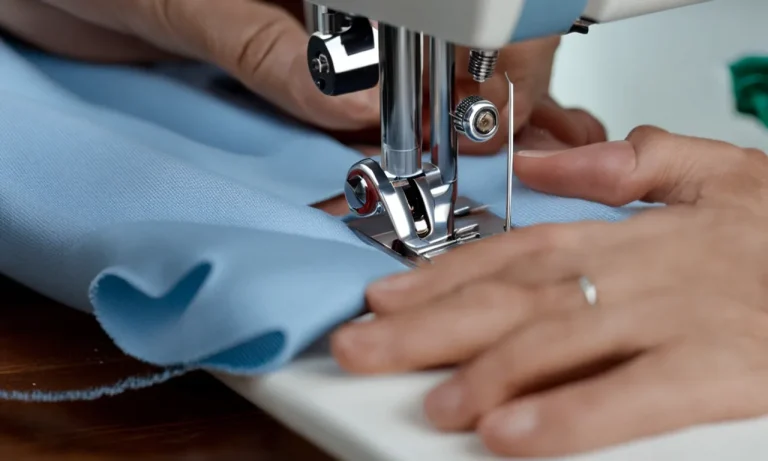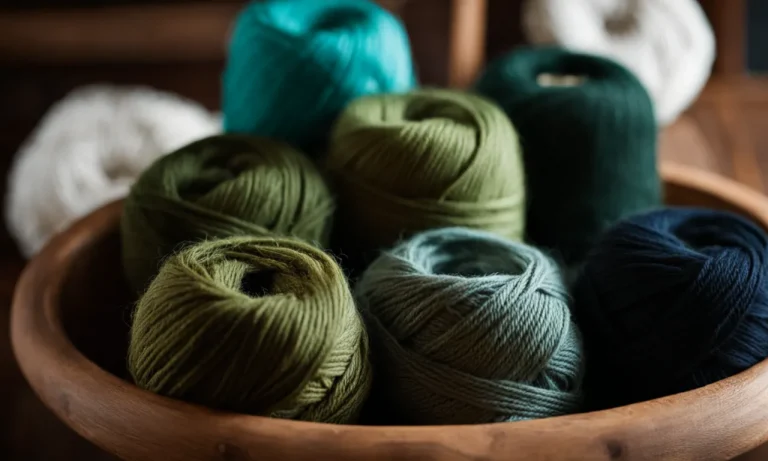Where Does Fabric Come From? A Detailed Look At Fabric Origins
Fabric is all around us – in our clothes, furniture, carpets, and more. But have you ever wondered exactly where fabric comes from and how it’s made? The origins of fabric are actually quite fascinating.
If you’re short on time, here’s a quick answer to your question: Fabric can be made from natural materials like cotton, wool, and silk that come from plants and animals, or synthetic materials like polyester that are made from chemicals and petroleum.
In this comprehensive guide, we’ll take a close look at the various sources that different fabrics come from, the processes used to harvest and manufacture them into textiles, and the path they take from raw materials to fabrics in stores and our homes.
Plant-Based Natural Fibers
When it comes to fabric origins, plant-based natural fibers play a crucial role in the textile industry. These fibers are derived from various plants and have been used for centuries to create comfortable and breathable fabrics.
Let’s take a closer look at some of the most popular plant-based natural fibers:
Cotton
Cotton is perhaps the most well-known and widely used natural fiber. It comes from the fluffy fibers that surround the seeds of the cotton plant. Cotton is highly versatile and can be found in a wide range of textiles, from clothing to home furnishings.
It is known for its softness, breathability, and absorbency, making it a popular choice for warm climates and everyday wear.
Linen
Linen is derived from the flax plant and is known for its strength and durability. It has been used for centuries to create a variety of fabrics, including clothing, bedding, and tablecloths. Linen is highly breathable and has excellent moisture-wicking properties, making it a great choice for summer clothing.
It also has a natural luster and a slightly crisp texture, giving it a luxurious feel.
Hemp
Hemp fibers come from the stalks of the cannabis plant. They are known for their strength and durability, as well as their sustainability. Hemp fabrics are becoming increasingly popular due to their eco-friendly properties.
Hemp is naturally resistant to pests and requires little to no pesticides, making it a more sustainable alternative to other plant-based fibers. It can be used to create a wide range of textiles, from clothing to accessories.
Jute
Jute is a long, soft, and shiny fiber that comes from the jute plant. It is primarily grown in Bangladesh and India. Jute fibers are primarily used to create burlap, which is commonly used for packaging, bags, and other coarse fabrics.
Jute is a highly sustainable fiber as it grows quickly and requires minimal fertilizers and pesticides. It is also biodegradable, making it an environmentally friendly choice.
Ramie
Ramie is a natural fiber derived from the stem of the Chinese nettle plant. It is known for its strength, durability, and silky appearance. Ramie has been used for centuries to create fabrics that are lightweight, breathable, and resistant to shrinkage.
It is often blended with other fibers like cotton to enhance its properties. Ramie is commonly used in the production of household textiles, such as tablecloths and curtains.
Sisal
Sisal is a strong and durable natural fiber that comes from the leaves of the agave plant. It is commonly used to create ropes, twines, and carpets. Sisal has excellent heat resistance and is resistant to deterioration from saltwater, making it ideal for marine applications.
It is also biodegradable and renewable, making it an environmentally friendly choice.
These plant-based natural fibers provide a sustainable and eco-friendly alternative to synthetic materials. Their versatility, durability, and breathability make them a popular choice for a wide range of textiles.
From the softness of cotton to the strength of sisal, these fibers have played a crucial role in the development of the textile industry.
Animal-Based Natural Fibers
Animal-based natural fibers are an essential part of the fabric industry, providing us with a wide range of textiles that are both luxurious and durable. Let’s take a closer look at some of the most popular animal-based natural fibers used in fabric production.
Wool
Wool is one of the most well-known animal-based natural fibers, sourced primarily from sheep. It is highly versatile and offers excellent insulation, making it suitable for a variety of garments and household items.
Wool comes in different grades, with merino wool being highly prized for its softness and warmth. It is commonly used in sweaters, blankets, and outerwear.
Silk
Silk is a delicate and lustrous natural fiber that is produced by silkworms. It is known for its luxurious feel and shimmering appearance. Silk fabric is lightweight, breathable, and has excellent draping qualities, making it ideal for elegant clothing such as dresses, blouses, and scarves.
Silk production involves carefully unraveling the cocoons of silkworms, which can be a labor-intensive process.
Alpaca
Alpaca fiber is derived from the fleece of alpacas, a domesticated South American animal. Alpaca wool is prized for its softness, warmth, and hypoallergenic properties. It is often compared to cashmere for its luxurious feel.
Alpaca fiber comes in a range of natural colors and is commonly used in sweaters, shawls, and other cold-weather garments.
Mohair
Mohair is a natural fiber obtained from the fleece of Angora goats. It is known for its lustrous sheen and exceptional durability. Mohair is often blended with other fibers to enhance its properties. It is commonly used in upholstery fabrics, as well as in sweaters and accessories.
Cashmere
Cashmere is a highly sought-after and luxurious natural fiber obtained from the underbelly of cashmere goats. It is known for its incredible softness, warmth, and lightweight feel. Cashmere is a premium material and is often used in high-end sweaters, scarves, and other luxury items.
These animal-based natural fibers play a significant role in the fabric industry, providing us with a diverse range of textiles that cater to different needs and preferences. Understanding their origins and properties allows us to appreciate the craftsmanship and sustainability behind these fabrics.
Manufactured Fibers
When it comes to fabric, not all materials are naturally occurring. In fact, many fabrics that we use today are made from manufactured fibers. These fibers are created through various chemical processes that transform raw materials into the soft and versatile materials we know and love.
Let’s take a closer look at some of the most common types of manufactured fibers.
Rayon
Rayon, often referred to as “artificial silk,” is a popular manufactured fiber that is derived from natural sources such as wood pulp or cotton linter. It is known for its softness and breathability, making it a popular choice for clothing and home textiles.
Rayon can have a luxurious feel and is often used in high-end fashion garments.
Acetate
Acetate is another manufactured fiber that is derived from cellulose. It is known for its silk-like appearance and drape, making it a popular choice for linings, lingerie, and eveningwear. Acetate is also often blended with other fibers to enhance their performance and durability.
Nylon
Nylon is a synthetic manufactured fiber that was first developed in the 1930s. It is known for its strength and durability, as well as its quick-drying properties. Nylon is commonly used in a wide range of applications, including clothing, swimwear, and outdoor gear.
Its versatility and ability to withstand wear and tear make it a favorite among designers and consumers alike.
Polyester
Polyester is one of the most widely used manufactured fibers in the world. It is known for its durability, wrinkle resistance, and easy care properties. Polyester is often blended with other fibers to create fabrics that are soft, breathable, and moisture-wicking.
It is commonly used in clothing, home textiles, and upholstery.
Acrylic
Acrylic is a synthetic fiber that is known for its wool-like softness and warmth. It is often used as a substitute for wool in knitwear and blankets. Acrylic is lightweight, easy to care for, and resistant to fading and shrinkage.
It is a cost-effective alternative to natural fibers and is commonly used in mass-produced items.
Spandex
Spandex, also known as Lycra or elastane, is a stretchy synthetic fiber that is commonly used in athletic wear, swimwear, and form-fitting garments. It provides excellent elasticity and shape retention, allowing for freedom of movement and a comfortable fit.
Spandex is often blended with other fibers to enhance their stretch and recovery properties.
Manufactured fibers have revolutionized the textile industry, offering a wide range of options in terms of durability, performance, and aesthetics. Whether you’re shopping for clothing, bedding, or upholstery, understanding the origins of these fibers can help you make informed choices and appreciate the innovation behind the fabrics we use every day.
The Manufacturing Process
Harvesting/Obtaining Raw Materials
The manufacturing process of fabric begins with the harvesting or obtaining of raw materials. Depending on the type of fabric being produced, these raw materials can vary. For example, cotton is obtained from cotton plants, while silk is derived from the cocoons of silkworms.
Other raw materials used in fabric production include wool, linen, and synthetic fibers like polyester and nylon.
Harvesting raw materials involves careful cultivation and collection. Cotton is typically harvested by picking the cotton bolls from the plants, while silk is obtained by carefully unraveling the cocoons without damaging the silk threads inside.
This stage is crucial, as the quality of the raw materials affects the overall quality of the fabric.
Cleaning and Processing
Once the raw materials are obtained, they need to be cleaned and processed to remove impurities. For example, cotton fibers need to be separated from seeds, leaves, and other debris. This is done through a process called ginning, which involves using machines to separate the cotton fibers from the seeds.
Similarly, silk cocoons are boiled to soften the glue-like substance that holds the silk fibers together. After boiling, the silk threads are carefully unwound and cleaned. This cleaning and processing stage ensures that the raw materials are pure and ready for the next step in the manufacturing process.
Spinning into Yarn/Threads
Once the raw materials are cleaned, they are spun into yarn or threads. This process involves twisting and winding the fibers together to create a continuous strand. Spinning can be done using traditional spinning wheels or modern spinning machines.
During spinning, the fibers are stretched and twisted, which gives the yarn strength and durability. The thickness of the yarn can be adjusted depending on the desired fabric weight. Thicker yarns are used for heavier fabrics, while thinner yarns are used for lighter fabrics.
Weaving or Knitting into Fabric
After the yarn is spun, it is ready to be woven or knitted into fabric. Weaving involves interlacing the yarns at right angles to create a woven fabric. This is done on a loom, where the vertical yarns, called the warp, are held taut while the horizontal yarns, called the weft, are passed through them.
Knitting, on the other hand, involves creating loops with yarn and interlocking them together to form a fabric. Knitted fabrics have more stretch and flexibility compared to woven fabrics.
The choice between weaving and knitting depends on the desired characteristics of the fabric. Woven fabrics tend to be more structured and stable, while knitted fabrics are softer and more stretchy.
Finishing Touches
Once the fabric is woven or knitted, it undergoes various finishing processes to enhance its appearance, feel, and performance. These processes include bleaching, dyeing, printing, and adding special finishes like water repellency or wrinkle resistance.
Bleaching is done to remove any natural color from the fabric, making it white or close to white. Dyeing involves adding color to the fabric, either through immersion in dye baths or by printing the fabric with dyes.
Special finishes can be applied to enhance the fabric’s functionality, such as adding flame retardant properties or improving moisture-wicking capabilities.
After the finishing touches are applied, the fabric is inspected for quality and then packaged for distribution to manufacturers or retailers.
Conclusion
As you can see, the origins of fabric are diverse – from plants like cotton and flax, to animals like sheep and silkworms, to synthetic materials derived from petroleum. The process of turning these raw materials into wearable fabrics is lengthy and complex, involving harvesting, cleaning, spinning, weaving or knitting, and finishing stages.
So the next time you get dressed, touch a piece of furniture, or see fabric all around you, you can appreciate the fascinating journey that material went through to become part of your life. Fabric connects us to nature, animals, science, and human ingenuity in ways we don’t often stop to ponder.







